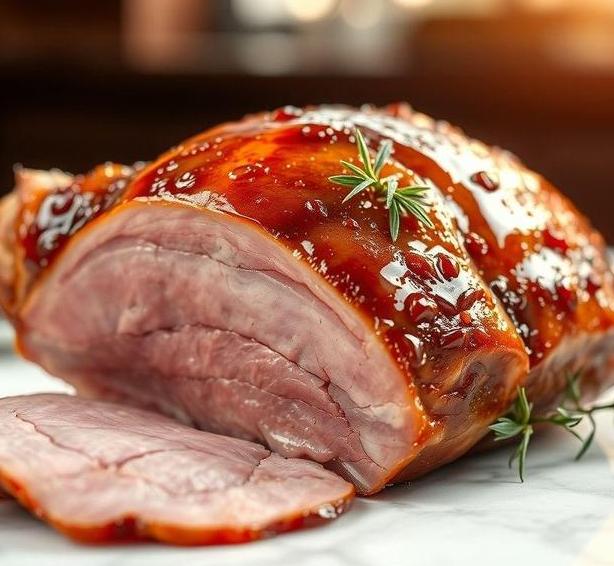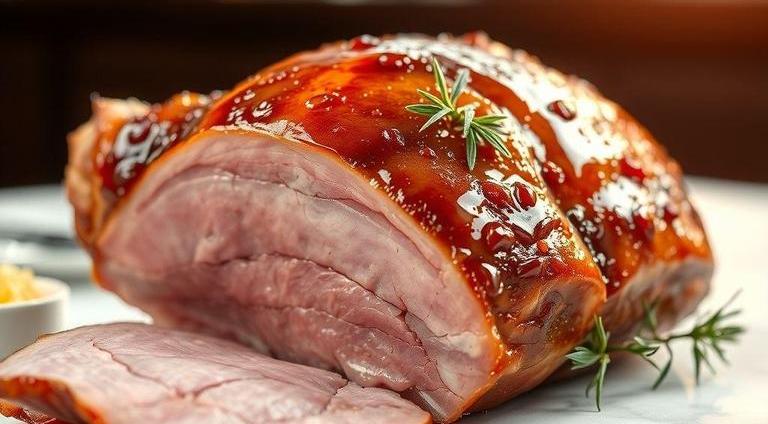Whether you’re dealing with leftover ham after a grand holiday meal or planning on buying a whole ham for the future, it’s essential to know how to properly handle and store it. Understanding how to extend its shelf life and recognize when it’s no longer safe to eat can help prevent waste and ensure your ham remains safe and delicious.
Let’s dive deep into everything you need to know about bone-in ham, from how long it lasts to how to store it properly.
Can Bone-in Ham Go Bad?
Yes, bone-in ham can absolutely go bad. Like any other meat, it has a limited shelf life once it is cooked or opened. The potential for spoilage mainly depends on how it’s handled, stored, and whether it’s cooked or uncooked.
Several factors influence how long your bone-in ham lasts, such as:
- Temperature: Ham stored at the wrong temperature (like being left at room temperature for too long) can spoil rapidly.
- Packaging: Whether it’s tightly wrapped or exposed to air can affect how well it keeps.
- The Age of the Ham: If it’s been sitting in your fridge for a while, the chances of spoilage increase.
One important thing to note is that cooked ham has a shorter shelf life compared to uncooked ham. This is because cooked ham is more susceptible to bacterial growth once it’s been prepared, especially if not stored correctly.
Shelf Life For Bone-in Ham

The shelf life of bone-in ham can vary widely depending on a few key variables. Let’s break it down for both cooked and uncooked bone-in ham:
Uncooked Bone-in Ham
If you’ve purchased an uncooked bone-in ham, it will last for a longer time in your fridge compared to cooked ham. Here’s a rough timeline:
- Refrigerator (unopened): Can last up to 1 week after the sell-by date if stored properly at 40°F or below.
- Freezer (unopened): You can freeze an uncooked ham for up to 6 months without compromising too much quality. Beyond that, the flavor may begin to degrade, but it will still be safe to eat.
Cooked Bone-in Ham
Once cooked, your bone-in ham has a much shorter shelf life. Even though it’s already been processed, it still needs careful handling to stay fresh:
- Refrigerator (opened): Cooked ham will last about 3-5 days in the fridge if stored correctly. After this point, it can begin to spoil.
- Freezer (opened): In the freezer, it will last up to 6 months, but ideally, you should consume it within 1-2 months for optimal quality.
Sliced Bone-in Ham
If you’ve sliced your ham into smaller pieces, its shelf life will be shorter:
- Refrigerator (sliced): Lasts about 3-4 days in the fridge.
- Freezer (sliced): You can freeze sliced ham for up to 1-2 months, and it should still be safe and tasty.
Common Signs Of Spoilage
Knowing how to spot a bad ham is crucial for food safety. Here are some common signs of spoilage to watch out for:
- Off-Scent: Ham that has gone bad will develop a sour or rancid smell. If it smells unpleasant or has an ammonia-like odor, it’s time to toss it.
- Slimy Texture: If the surface of the ham feels slippery or slimy, it’s likely that bacteria or mold has started to grow. This is a red flag for spoilage.
- Discoloration: Fresh ham should have a nice pink or reddish color. If you notice any gray, brown, or greenish patches, it’s a sign that the ham is no longer safe to eat.
- Mold: While some hams may have a natural white coating due to curing salts, visible mold (especially black or green) indicates that the ham has been contaminated and should be discarded.
- Unusual Taste: If it tastes sour, rancid, or otherwise off when you take a bite, it’s a sure sign that the ham has spoiled. Trust your taste buds!
- Expiration Date Passed: While it’s not always a surefire way to determine spoilage, the expiration or sell-by date can give you a good idea of when the ham may go bad. If it’s long past that date, the risk of spoilage increases.
How To Store Bone-in Ham?

Proper storage is key to keeping bone-in ham fresh and safe to eat. Here are the best ways to store both uncooked and cooked bone-in ham:
Storing Uncooked Bone-in Ham
- Keep It Refrigerated: If you plan to cook the ham within a few days of purchase, store it in the fridge at a consistent temperature of 40°F or lower. Keep it in its original packaging until you’re ready to cook it.
- Freeze for Long-Term Storage: If you’re not planning on using the ham soon, freezing is your best option. Wrap it tightly in plastic wrap or aluminum foil, then place it in an airtight freezer bag or container to avoid freezer burn.
Storing Cooked Bone-in Ham
- Refrigerate Leftovers: After cooking, allow the ham to cool completely before refrigerating it. Wrap it tightly in plastic wrap, aluminum foil, or place it in an airtight container to keep out air and moisture, which can promote spoilage.
- Store Slices Separately: If you’ve already sliced your ham, it’s a good idea to store the slices separately. This can help maintain their texture and prevent the edges from drying out. Store slices in an airtight container or tightly wrapped.
Freezing Cooked Bone-in Ham
If you have leftover cooked ham, freezing it is a great way to preserve it. Here’s how to freeze your cooked ham:
- Wrap it well: Make sure to wrap it tightly in plastic wrap or foil. Follow this by placing it in a resealable freezer bag or an airtight container.
- Avoid Freezer Burn: If you plan to freeze smaller portions, do so in individual serving sizes. This makes it easier to thaw just what you need without exposing the entire ham to the thawing process.
Expert Tips
- Avoid Leaving Ham Out Too Long: Ham, like all meat, should not be left out at room temperature for more than 2 hours. Bacteria multiply rapidly at room temp, so it’s essential to refrigerate or freeze it promptly.
- Use a Meat Thermometer: If you’re unsure whether your ham has reached the right internal temperature during cooking, a meat thermometer can help. A bone-in ham should be cooked to an internal temperature of 145°F to be safe.
- Don’t Trust Your Eyes Alone: While visible mold or color changes are obvious signs of spoilage, don’t rely solely on visual cues. Always trust your sense of smell and taste too. Spoiled ham may not always look bad but can still be unsafe to eat.
- Cool Leftovers Quickly: If you have leftover ham, it’s important to cool it quickly before storing it in the fridge. You can do this by cutting the ham into smaller pieces, allowing it to cool faster.
- Avoid Freezing More Than Once: Re-freezing ham after it’s been thawed can cause a loss of texture and flavor. Once you thaw frozen ham, eat it within 3-4 days, or use it for another dish like soups, casseroles, or sandwiches.
FAQs
How Long Does Bone-in Ham Last In The Fridge?
Bone-in ham can last in the refrigerator for up to 5-7 days when properly stored at or below 40°F (4°C). It should be wrapped tightly in plastic wrap or aluminum foil to maintain freshness.
Can Bone-in Ham Spoil If Left At Room Temperature?
Yes, bone-in ham can spoil if left at room temperature for more than 2 hours. The growth of bacteria increases rapidly at temperatures between 40°F (4°C) and 140°F (60°C), so it’s essential to refrigerate or freeze it promptly.
How Can You Tell If Bone-in Ham Has Gone Bad?
Signs that bone-in ham has gone bad include an off or sour smell, discoloration (especially dark or green spots), slimy texture, or a change in taste. If any of these occur, it’s best to discard the ham.
Can You Freeze Bone-in Ham To Extend Its Shelf Life?
Yes, you can freeze bone-in ham to extend its shelf life. When properly wrapped in freezer-safe materials, it can last for up to 6 months in the freezer without losing quality.
How Long Can You Freeze Bone-in Ham?
Bone-in ham can be stored in the freezer for up to 6 months. However, for best quality, it’s recommended to consume it within 1-2 months after freezing.
Is It Safe To Eat Bone-in Ham After The Expiration Date?
It is not recommended to eat bone-in ham after the expiration date, as the quality and safety of the product may decline. Always check for signs of spoilage before consuming any meat past its expiration date.
Can Bone-in Ham Go Bad If It’s Cooked?
Yes, even cooked bone-in ham can go bad if stored improperly or kept for too long. Once cooked, it should be consumed within 3-5 days when refrigerated and up to 1-2 months when frozen.
How Should You Store Leftover Bone-in Ham?
Leftover bone-in ham should be stored in an airtight container or wrapped tightly in plastic wrap and aluminum foil. Refrigerate it promptly and consume within 3-5 days for the best quality.
Can Bone-in Ham Be Stored In Its Original Packaging?
Bone-in ham can be stored in its original packaging if unopened and kept in the fridge. Once opened, it should be rewrapped securely or placed in an airtight container for best preservation.
What Happens If You Eat Bad Bone-in Ham?
Eating spoiled bone-in ham can lead to foodborne illnesses, with symptoms such as stomach cramps, vomiting, diarrhea, and fever. It’s crucial to discard any ham showing signs of spoilage to avoid food poisoning.